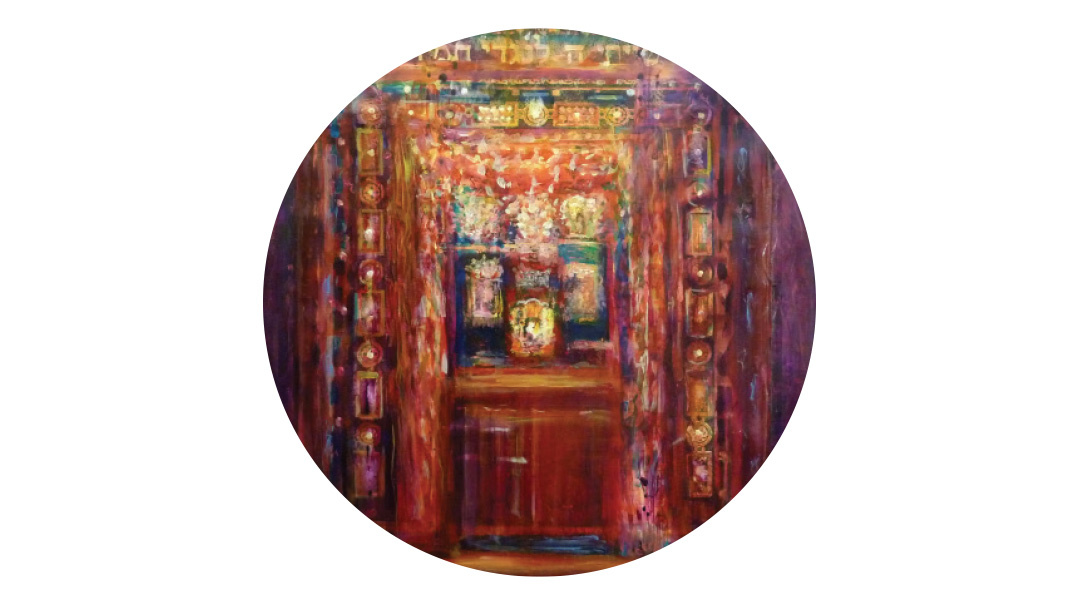Step by Step

We see our struggles; He sees our potential
As I write from my Har Nof “bunker,” the world as we knew it has come to a grinding halt. The coronavirus statistics are daunting. Over 80% of the global work force of 3.3 billion people have had their workplace fully or partly closed. And 90% of the world’s students are out of class.
The Talmud Yerushalmi (Shabbos 6:9) teaches us that when Hashem talks to us through events of nature, it’s called a bas kol. One needs the lenses of daas Torah to ensure that the interpretation of the bas kol is healthy and grounded. But it’s often a wakeup call urging us to focus on something that deep down we knew we should be working on.
Our gedolim and mechanchim are guiding us with vital suggestions for self-improvement based on observing Hashem’s New World.
Can I humbly take note of a shocking statistic and suggest one more?
Eighty percent of deaths associated with coronavirus in the United States are in adults aged 65 and older, according to an analysis by the Centers for Disease Control and Prevention (CDC). The elderly are suffering most from this outbreak.
One of the signs of Ikvesa D’Meshicha (the era that precedes Mashiach) is the chutzpah youth display toward the elderly. “The youth will shame the face of the elders; elders will stand before minors” (Sotah 49b). Just see how terrified parents are of their own children. As one wise mechanech quipped, “The chutzpah is in the air, kids from the best homes just breathe it in.”
Coronavirus is forcing us to readjust our lives to protect this particular age group, those who have been bereft of the basic kavod that just a generation ago was natural. Perhaps Hashem wants us to reflect and ask ourselves a simple question: Are we giving the senior generation the kavod they deserve?
Missing Respect
Rabi Akiva had 12,000 pairs of talmidim (set up as chavrusos across the country) from Gabbas to Antipras, and all of them died at the same time (between Pesach and Shavous) because they didn’t treat each other with respect (Yevamos 62b).
Rabi Akiva’s students weren’t ordinary talmidim. They were handpicked by Rabi Akiva to build a post-Churban world that would guide Klal Yisrael through a bitter galus. They were to be the future leaders of the Jewish People. Rabi Akiva spread them throughout the country rather like a State University system in the United States.
These talmidim were trained to be Tannaim, teachers of such lofty spirit they were on level where they could perform techiyas hameisim (see Avodah Zara 10b). How could they be guilty of treating each other without respect, especially when the central message of their teacher was v’ahavta lerei’acha kamocha, love your neighbor like yourself?
Ramban (Kedoshim 19:18) explains that it’s a struggle to know your friend as well as you know yourself, to see the world through his lenses. How can you love someone like yourself unless you can feel his pain the way he feels it? Feel his needs as he feels them?
My rebbi, Rav Shlomo Wolbe ztz”l, used to talk about this sensitivity all the time. Sometimes we even need to compromise hiddurim in mitzvos for our fellow Jew, he’d say. For example, the halachah states you may raise your voice while davening Shemoneh Esreh on the Yamim Noraim to help you have kavanah. Rav Wolbe would cry, “Don’t do it if it may disturb the person next to you!”
Surely my rebbi wouldn’t be insulted if I said that his bein adam l’chaveiro was on a lower level than that of his own rebbi, Reb Yerucham Levovitz of the Mir. He, in turn, wasn’t on the level of Reb Yisrael Salanter, who famously took the minimum requirement of water to wash his hands for bread, so the maid who schlepped the water from the well wouldn’t have to carry that extra bit of water.
As we go back in time, we need to stretch our imagination to the fullest to picture the kavod that, for example, Rashi’s students would give each other. Once we hit Talmudic times we can give our imagination a rest — these giants are beyond our comprehension!
So what does it mean that Rabi Akiva’s students did not have kavod for each other? Surely they stood up for each other, listened attentively to each other, cared for each other’s every need, and loved each other with every fiber of their heart and soul.
A Bas Kol That’s Still Crying
“Rav Yehoshua ben Levi said, ‘Every day a bas kol emanates from Har Chorev (Mount Sinai), proclaiming and saying, “Woe to the people (Klal Yisrael) who allow the Torah to be insulted!’ ” (Avos 6:2)
The Torah was given at Har Sinai with fire, with thunder and lightning. This display of kavod wasn’t just there for “dramatic effect,” it was an intrinsic part of how Torah must be received. The kavod that accompanied the giving of the Torah is reflected in how we take sifrei Torah out of an Aron Hakodesh and how we treat our seforim. Most of all, it’s seen in how we treat our Torah scholars, the living sifrei Torah.
Reb Chaim of Volozhin reports that when his rebbi, the Vilna Gaon, would mention the Arizal, his entire body would shake. Reb Baruch Ber’s hand would tremble when he’d mention the name of his rebbi, Reb Chaim Brisker. Some of us have had the zechus to be present in the face of gadlus and can testify how our hearts race before asking a question to Rav Chaim Kanievsky shlita or Rav Gershon Edelstein shlita.
I’d like to suggest there’s another aspect of kavod haTorah we often ignore. Picture a king riding in his royal carriage surrounded by the pomp and ceremony of an entourage. The aristocracy greet him to the sound of trumpets. What further honor could possibly be bestowed upon his majesty?
Somewhere in the crowds is a simple villager who has traveled miles for a glimpse of his monarch. Surely his contribution to the dignity of the moment borders on irrelevance.
But the king is wise and sees things differently. He sees the villager’s efforts to wear his finest clothing, despite them being objectively simple. He sees the expenditure and fatigue involved in the journey to the capital. He senses the pounding of the man’s heart as the procession approaches. The villager hasn’t honored the king with the classic displays of honor; he has honored the king with something subtle yet sublime.
He’s honored the king through his exhaustive efforts to show him respect.
Envision a child memorizing the Mah Nishtanah, excited to be part of the Seder.
An exhausted lawyer getting on the train at Inwood Station at 7:53 a.m. on the way to Penn Station. He’d prefer to relax and read the New York Times, but pushes himself to join the daf yomi in the last carriage.
A teen labeled “at risk” choosing to play pool with his rebbi and allowing his mind to be stimulated by a shared Torah thought.
My late mother-in-law, Mrs. Lorraine Brown of Memphis, relaxing on her favorite armchair after bentshing licht on Friday night. She lovingly picks up her linear Chumash and starts to learn Rashi before drifting off to sleep.
At first glance, these moments are trivial and unimpressive. But in the eyes of the King of kings, the small steps people push themselves to take in order to come closer to Him is a beloved and precious kavod.
The Maharal’s Revelation
In a sense, these two types of kavod — the King’s intrinsic kavod and the kavod that comes from the yearning and struggles to be close to the King — can be seen in the life story of Rabi Akiva himself. Picture the kavod haTorah generated by Rabi Akiva, the leading scholar of his generation and acknowledged spiritual leader of the Jewish people, when he returned home after 24 years away, escorted by 24,000 devoted talmidim.
Turn the clock back 24 years and picture the same Akiva as a humble shepherd, descendent of converts, struggling to achieve a seemingly impossible dream with his wife Rachel.
The first type of kavod is expressed on Shavuos when we experienced kabbalas haTorah with all its majesty and splendor. In the terminology of the Acharonim, it represents the 50th level of kedushah, an other-worldly level of spiritual perfection.
The second type of kavod is expressed during Sefiras Ha’omer. It’s a journey through 49 levels, through the challenges of struggling in the material world. It’s a step-by-step process of spiritual growth taken by the rank and file soldiers of the Jewish people. It’s expressed through their struggles and exertions, their falling and picking themselves up, their tears of frustration and joy, their introspection and soul-searching.
It’s the kavod given to Hashem by you and me.
The Maharal (Nesiv Hatorah 12) divides Sefiras Ha’omer into two parts. The first 32 days are the central days when we’re expected to focus on kavod haTorah. He notes that kavod in gematria is 32. On the 33rd day, Lag B’omer, we enter the last third of the Omer, and the holy light generated by the kavod we’ve worked on can begin to shine.
The Maharal develops his idea further. Lag B’omer is the 18th (chai) day of Iyar. The gematria of Iyar (221) is the same as arech, a reference to the longevity that Torah brings, as the verse in Mishlei says, “Arech yamim b’yeminah.” Lag B’omer is literally chai arech, a time for life and longevity, ki hem chayeinu v’orech yameinu.
It’s the perfect day for the plague killing Rabi Akiva’s students to end.
Tragic Error
Rabbi Akiva wanted his students to be the foundation of a Torah society that would sustain us throughout galus. There’s no question that they exuded kavod haTorah that echoed the 50th level of kedushah. Without doubt, their middos were perfect. But perhaps we can say that on their lofty level, they failed to see the great honor given to Hashem through the struggles of their chaveirim.
For example, in Talmudic discourse a chavrusah suggests a svara (thought), and his colleague respectfully, but often forcefully, shows the error in his approach. That failed svara was an attempt to learn the emes in Hashem’s Torah. Hashem sees the kavod in failure as well. The chavrusah, tragically, did not.
Rabi Akiva’s students died during the first 32 days of Sefirah because those are the main days when we work on kavod haTorah. They died from askara, a disease that diminishes breath, because that struggle is the spiritual oxygen of the Jewish People.
Cherishing Our Elderly
It’s interesting to note that the Hebrew word zakein has two meanings. The simple translation is someone old. But it also means someone wise. Zakein is an acronym for zeh kana chochmah, this person has acquired wisdom.
When we stand up for a Torah scholar, we’re acknowledging the kavod of the 50th level of kedushah, a living sefer Torah. When we stand up for the elderly, we should see a lifetime of honoring Hashem by struggling through the 49 levels of kedushah. Our challenge is to see the accomplishments that emanate from their taking life experience and using it as fuel for growth.
Next time we put on our masks and step outside, let us pause and reflect how much our parents, grandparents, and the elderly in our lives mean to us. The chutzpah towards the older generations is Ikvesah D’Meshicha in the air. Let’s not be part of the problem.
The One Who Receives the Least Kavod
Another major problem in our generation is that we forget to give kavod to one crucial person.
Ourselves.
Our generation has alarming statistics for low self-esteem, anxiety and depression to the point that on some level, it affects us all. To correct this, a first step is to use the days of Sefiras Haomer to recognize that Hashem’s infinite love for us includes seeing greatness in our struggles. If we cannot be Rabi Akiva, let us be Akiva, the dreamy-eyed shepherd. Let us remember when we pick ourselves up after a fail and try again, we unleash kavod hatorah that parallels the kavod hatorah surrounding our gedolim. We should be proud!
After his talmidim died, Rabbi Akiva courageously rebuilt the world from scratch. This time he focused on five talmidim who could understand v’ahavta lerei’acha kamocha on every level. They could hear the bas kol from Sinai crying for the kavod inside the hearts of every single Jew. Their illustrious leadership was to be the shining lights to sustain us through galus.
In these extraordinary days, let us be part of the revolution that brings the Redemption. Let us give kavod hatorah to our gedolim. Let us marvel and respect the struggles of our friends. Let us try to reverse the youth-obsessed tendencies of our generation in favor of our elders. Crucially, let us acknowledge the greatness in ourselves that comes from our own yearning for closeness to Hashem.
Most of all, let us daven to Hashem that everything we’re going through now shouldn’t end with “things going back to normal.”
Normal was never good.
Let us plant the fertile soil that brings Mashiach.
(Originally featured in Family First, Issue 691)
Oops! We could not locate your form.







